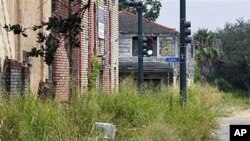On August 29, 2005, over a 12-hour period, Hurricane Katrina ripped through the Gulf coast of the United States with winds up up to 233 kilometers per hour [145mph] - killing more than 1,700 people and displacing hundreds of thousands. Seven years later, residents of the area still are struggling to rebuild. And while the effects of the storm remain evident, there also are some striking improvements.
In the aftermath of Katrina, the city of New Orleans was in ruins. One hundred twenty of the city’s 200,000 homes were destroyed. Eighty percent of the city was flooded.
“It wasn’t the hurricane that destroyed the city. It was the collapse of its levees,” said John Bigounet, who writes books and plays about the hurricane and its aftermath. He blames the disaster on problems with the flood-protection system.
“You could see the flood line. And it was clear that the water hadn’t come over the top of the levees. Instead that they had collapsed from the bottom. The reason that they collapsed from the bottom was that not enough steel was used," said Bigounet.
Fourteen billion dollars has now been spent to re-build the flood-protection system. Billions of dollars more have been spent on re-developing other parts of the city. But photographer Frank Relle, who has been documenting the city's recovery, said the results so far have been mixed.
“You have a new library that’s being built right here. But at the same time you have individuals that are struggling to rebuild. This house was knocked off its foundation by Katrina. Still got photographs on the floor. This is someone’s birth certificate,” said Relle.
Right after the disaster, many young professionals moved to New Orleans to help rebuild. Many decided to stay, including urban developer Milo Deamgan.
“This is an interesting time to be in New Orleans. A lot of different urban work is going on, a lot of different policy work is going on, and you have kind of passed that point of recovery. They call it resiliency now. And doing a lot more long-term strategic planning,” said Deamgan.
Bigounet said New Orleans now has less poverty than before, but that’s because many poor people simply could not afford to return.
“The city is a bit richer, a bit younger and a bit whiter than it was before the flood. The city is in flux right now. And because of that many people carry the scars of what they’ve been through in the last six years,” said Deamgan.
Relle said that's now the story of the city.
“As a documentary photographer, it’s sometimes strange that you need a disaster to have a voice heard," he said. "But really for me the reason why I wanted to do the work that I wanted to do, was to talk about difficult things, but also to give people hope and awareness.”
“I think like everyone who is writing about this, or photographing it, or painting it or writing songs about it, its changed who we are," said Bigounet. "We certainly have, I certainly have a different understanding of loss than I did before. I think the other thing that happened to us is that there’s a greater sense of compassion in those who survived.”
Hurricane Katrina changed New Orleans forever. It erased large parts of the city and those that have been rebuilt still have a long way to go. But a new city is starting to emerge.
“This was a place where my wife and I thought we could make the most difference in the world,” said Ben Jordan, a recent resident.
It's a city whose new and returning residents have a similar vision for its future.




